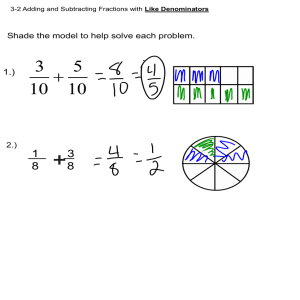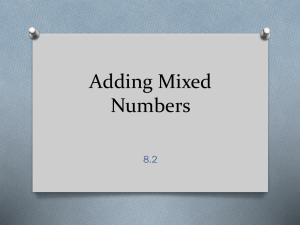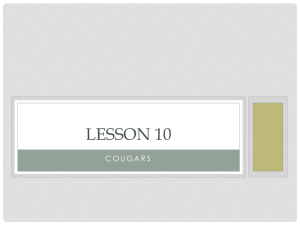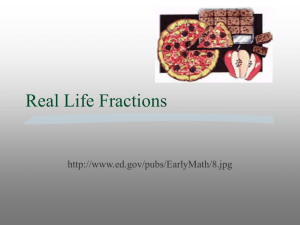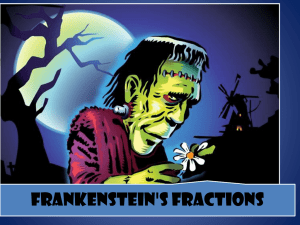21 st Century Lessons
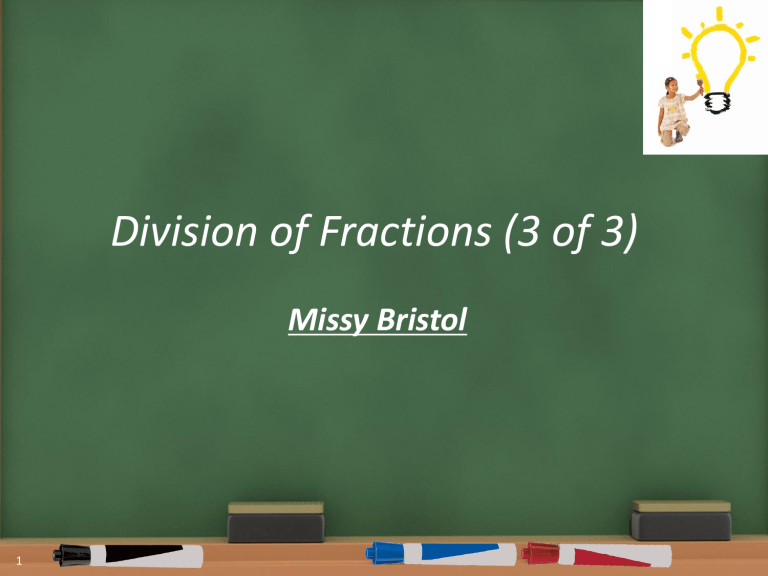
1
Division of Fractions (3 of 3)
Missy Bristol
9
Warm Up
Learning Objective: Students Will Be Able To… divide fractions using the common denominator method.
8
¸
5
9
We know that 5 wholes cannot “fit into” (8/9) so our answer is less than 1.
8
9
How many halves, (1/2), are there in an
Attempt to solve for the
5 quotient using the visual fraction models given. If you encounter trouble, record/explain what is giving you difficulty.
10
Agenda and Objective
Learning Objective: Students Will Be Able To… divide fractions using the common denominator method.
11
Lesson Vocabulary /Language Objectives
Words
•
Recognition
•
Translation
•
Rationality
•
Determine
•
Execution
• We will encounter these words later in the lesson.
• You do not need to write definitions.
• These words will help you with the process of solving word problems.
12
Launch 1A – Warm Up Revisited
Common Denominators 8
9
¸
5
1
Remember all whole numbers can be placed over a denominator of 1. Why?
Recall…
A common denominator/multiple is a number that both of our denominators can “fit into.”
It is helpful to find the least/lowest, but any common multiple can be used. In this problem,
9 and 1 “fit into” 9…which is the least common denominator. 18 is also a common multiple but not the least.
8 x 1 =
9 x 1 =
8
¸
45
9 9
= 9 x 5
= 9 x 1
Why is (45/9) an equivalent fraction to (5/1)?
13
Launch 1B – Get to the Division!!
8
9
¸
45
9
Divide from Left to Right
=
8
¸
45
9
¸
9
8
¸
45
9
¸
9
=
8
45
1
* Since any number (including a fraction) divided by 1 is itself…our quotient is… 8
45
And with practice you can move quickly…
8
9
¸
45
=
9
8
45
…the denominators “cancel” out (become 1)
14
Explore 1 – The Division Process
Fill in the missing numbers as indicated by the blank boxes. If the entire space is blank then you must supply all work necessary. “Fast Track” means that you may skip this step (optional).
Equation
Common
Denominators
Division Quotient
1)
2
3
¸
4
5
=
15
¸
15
=
15
¸
15
= 12
1 12
=
5
2)
5
6
¸
3
=
7
35
¸ =
¸
18
= 18 =
1
17
18
Fast Track
3)
2
13
¸
5
26
=
Explore 2 – Tying all Division Skills Together
Rosie is running a track race with five teammates. The course is 4 and (1/8) miles long. If all
6 team members want to run equal distances, how many miles will each be running?
15
1 Can you recognize the operation needed? (Add, Sub, Mult, or Div)
2
3
4
1
8
¸
6
1
= Can you translate this into a numerical equation?
Can you hypothesize what a rational solution might look like before actually solving? (will it be greater or less than 1)
Can you determine a method of solving the equation?
4
5
33
Execution
8
¸
6
1
=
Can you execute the accurate solution using skills learned?
33
¸
8
48
8
=
33
48
If you can, prove it !
=
48
=
11
16 miles
Take that!
1
Explore 3 – Fraction nitty gritty
Rohan is building a table and needs to purchase lumber. He has 8 and 2/3 feet of hard oak wood but determines that he needs 12 and 1/4 feet so he needs to buy the rest. Rohan will use 2/5 of the total 12 and 1/4 feet to make the legs of the table. This will be a tripod table so there will only be 3 legs.
a) How many feet of wood does Rohan purchase?
b) How many feet of wood is used to make the legs?
(all together) a) How long is each individual table leg?
b) How many feet of wood are used on the rest of the table? (if legs not included)
Agenda
16
17
Assessment
Name:__________ Key to Leave
Review your work from Explore 3 and compare your work to the solutions provided. At any point where your work is different or at any point that you don’t understand the solution process, explain either your confusion or what you did incorrectly. If your work matches exactly, write “I had that excatly.” (Be honest to help me understand where we stand). I should see much writing in the spaces on this page.
a) How many feet of wood does Rohan purchase?
12
1
4
-
8
2
3
=
49
-
4
26
3
147
12
-
104
12
=
43
12
=
3
7
12 ft b) How many feet of wood are used to make the legs? (all together)
2
5
·
147
12
=
294
60
=
4
54
60
=
4
9
10 ft c) How long is each individual table leg?
9
4
10
¸
3
1
=
49
10
¸
30
10
=
49
30
=
1
19
30 ft
147
12
-
49
10
=
735
-
60
294
=
60
441
60
=
7
21
60 ft d) How many feet of wood are used on the rest of the table? (if legs not included)
